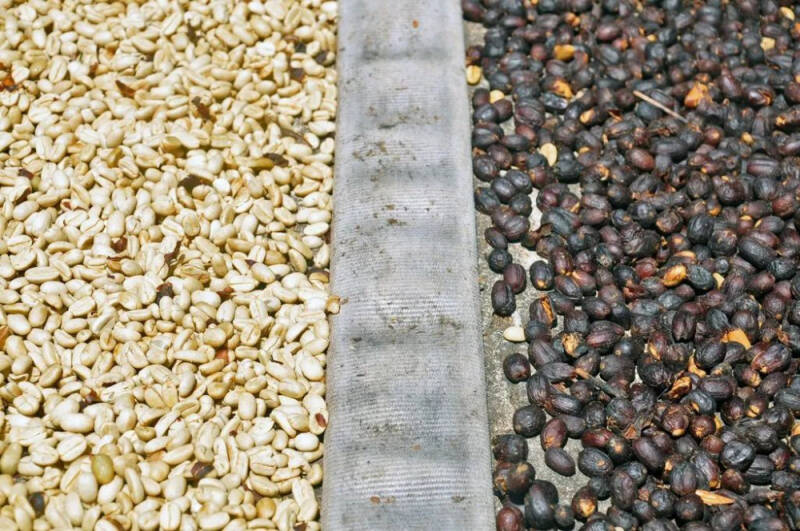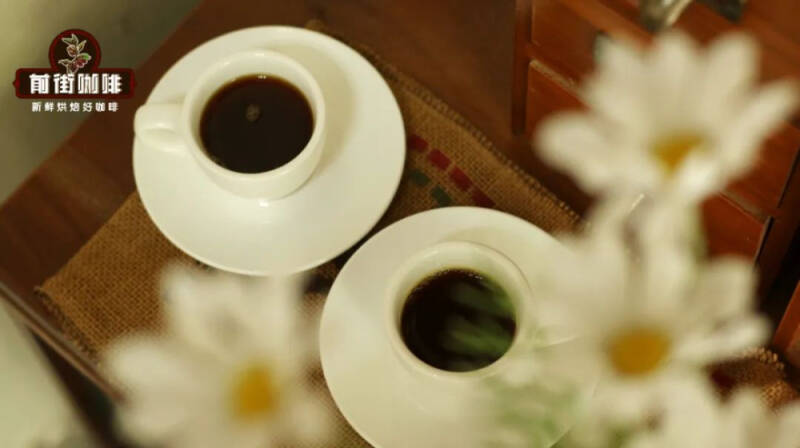Why are washed coffee beans more sour than sun exposure? How to say washed sun-dried coffee in English?
As a common term in the industry, tanning and washing are the two most mainstream processing methods in coffee production, and they are also the two treatments that many newcomers are most likely to come into contact with.

For those coffee lovers who are not practitioners, although it can be easily judged by their names that the two represent different things and there will be different steps and processes, it is very difficult to take a sip like a professional barista in the process of tasting. you can immediately guess whether it's sunburn or washing. So, what are the skills in this?
A friend once left a question backstage: is it true that sunburned coffee is sweeter and washed coffee is sour?

From the point of view of Qianjie, this statement is true, but it is not entirely true. Because a cup of coffee is sweet or sour, in addition to being affected by the treatment method, the coffee flavor is also controlled by variety, style, maturity, freshness, roasting, extraction, and so on. But if we only look at the treatment, we will find that the difference between tanning and washing is more reflected in the unique aroma and charm than the sour and sweet tastes.
Let's briefly review the steps of washing and tanning.
We need to know that no matter which method of treatment, the purpose is to get the raw bean part of the coffee fruit. The biggest difference between sun drying and washing is whether the outer skin and flesh of the bean is removed before drying.
Water washing, translated from Washed Process, also known as water washing process, is a traditional processing method that uses water resources to deal with coffee fruit. Generally speaking, the steps of washing include flotation, removal of pulp, removal of pectin after soaking and fermentation, washing or continued soaking, drying and shelling to get the coffee beans we need.
Compared to the sun, farmers who use water washing must be equipped with desizing machines, construction of washing pools and a continuous supply of running water, so it is not applicable everywhere, with Colombia, Costa Rica, Panama and Kenya as the most common. But washing does have a number of advantages: on the one hand, it reduces the defect rate of raw beans, thus stabilizing the quality, on the other hand, it greatly shortens the drying time, making production more efficient, and, of course, as we talk about today-- let the coffee retain the "washing flavor".
Solarization, which is called "Natural" in English, refers to natural non-technological processing methods. Since coffee was discovered in Ethiopia in the sixth century AD, tanning has been the only processing technology for coffee to circulate in the Arab world.
The traditional sun-drying method does not need to touch water at all, and the process of seed selection is also very simple. First, the whole coffee fruit is dried thoroughly, and then the inner beans can be obtained by rolling and shelling with a machine, and it can be done with the sun and a place to dry. However, the disadvantage of sun-cured coffee is also very obvious, that is, it is highly dependent on the weather, which requires up to a month of drying, and there is a high probability that previous efforts will be wasted if there is a windy and rainy month. So this ancient treatment tends to focus on tropical countries with dry and wet climates.
Let's take another look at the flavor of tanning and washing.
As the sun-dried coffee slowly dries the whole seed surrounded by the peel and pulp, the direct sunlight temperature provides favorable conditions for the sugar in the pulp and produces fermentation, releasing fermented acid and natural sugar into the seed, so the coffee produced will have a complex and changeable fruit flavor, as well as a mild wine body and fermentation flavor, which often shows tropical fruit, fermented flavor, brown sugar and so on.
Compared to the sun, washed raw beans need to be mechanically peeled and peeled before drying, and the remaining seeds and a layer of pectin are thrown into the sink to ferment, allowing the resulting acid to decompose the pectin. Soaking coffee beans in water for a long time causes some chemical changes in the beans and consumes a lot of monosaccharides (fructose and glucose), which in turn reduces the sugar content of coffee and increases various organic acids. Therefore, washed coffee tends to retain more beans' own aroma, with bright sour, clean and fresh characteristics.
"blindfolded" can you guess whether the coffee is washed or insolated?
In order to make a horizontal comparison, the sun version and washing version of the Panamanian butterfly were found in the front street, and then boiled in the same pot of hot water, and then two lucky spectators were selected for blind test. Considering that it is not easy to grasp the injection point of making two pots of coffee at the same time, the total water in Qianjie is divided into four stages for extraction, and other parameters are consistent as far as possible.
Powder quantity: 16g Powder / Water ratio: 1:15 Grinding degree: EK43s scale 10 Lattice Water temperature: 92 ℃ filter Cup: V60
Water injection technique: four-stage type
Sunflower butterfly: the entrance has the fragrance of sweet orange, persimmon, plum and other ripe fruit, accompanied by a slight sweetness of cocoa, even when the temperature drops, the acidity is not obvious, the taste is full and well balanced, and the tail rhyme is as warm and moist as black tea. at the same time, there is some aroma of roasted sweet potato.
Water-washed butterfly: the entrance can feel rich and bright acidity, reminiscent of many fresh and juicy fruits, such as lemon, grapefruit, green, as the temperature drops slightly, the coffee exudes the aroma of nuts and almonds, the sweetness of honey is mixed with elegant flowers, making the whole taste very light, just like drinking a cup of fresh green tea.
As expected, the lucky audience guessed the right answer when combining two cups of coffee.
Write to the end
I suddenly remembered that when I first joined the profession, Qianjie was asked by an elder: what kind of coffee do you like? At that time almost without the slightest hesitation to answer: the sun! Several years have passed, Qianjie has now seen no less than ten methods of treatment, but also lucky enough to taste their exquisite or complex or curious flavor, but still can not forget the most classic "tanning taste" in mind. Maybe I was still a rookie at that time, and it was precisely because I fell in love with the boutique coffee that I fell in love with it that I remembered it especially deeply.
So, as a coffee control, do you also have a favorite way to deal with it?
-END-
Important Notice :
前街咖啡 FrontStreet Coffee has moved to new addredd:
FrontStreet Coffee Address: 315,Donghua East Road,GuangZhou
Tel:020 38364473
- Prev

Sudden! Starbucks China announces high-level adjustments!
▲ Click to pay attention| Daily Boutique Coffee Culture Magazine Coffee Workshop This morning, Starbucks announced to all employees that it would adjust its leadership structure in China, which means that after Starbucks appoints a new global CEO, the coffee giant will also usher in a major power transfer in the China market. Starbucks announced that starting September 30
- Next

Egypt sends weapons to Somalia again! Tensions intensify in eastern Ethiopia
According to media reports, tensions in the Horn of Africa region have escalated again. Egypt recently delivered a new batch of important military aid to Somalia. This batch of goods includes heavy artillery, anti-tank weapons and armored vehicles. This is part of Egypt and Somalia in 2024. Part of the bilateral defense agreement signed in August. according to the Egyptian
Related
- What effect does Italian American coffee with filter paper have? Will coffee taste better if it is put on filter paper at the bottom of the powder bowl?
- What is the color difference in coffee beans? What are the characteristics of honey processed coffee beans? Why are the anaerobically treated coffee beans uneven in color?
- How does novice Xiaobai quickly get started and make coffee? Newbies learn to make coffee by hand and share the specific steps and process process!
- Costa tea has a shelf life of 100 years?! Expert: Unable to verify
- It's a huge uproar! American milk addition was rejected by Manner employees?!
- Mocha pot coffee bean recommendations| How fine and how much powder should be used for grinding? What parameter ratios do I need to use to make milk with Mocha pot coffee?
- What are the characteristics of the world's top ten coffee beans treated with Costa Rica honey? How to make black honey kadura from Tarazhu Pilon Processing Plant taste good?
- How to make deep-roasted coffee? What grinding water temperature does authentic Jamaica Blue Mountain No. 1 coffee use to brew it well?
- Selected high-grade rose summer coffee flavor tasting guide Why Panama rose summer has the aroma of flowers and fruits
- What equipment does a novice Xiaobai need to buy to learn to make coffee? Filter cup electronic scale bean grinder manual flushing pot purchase guide

